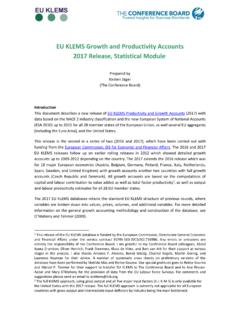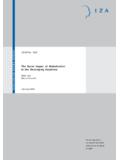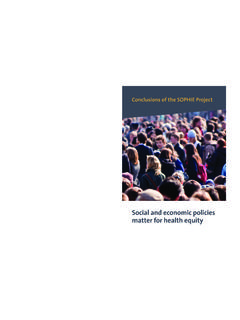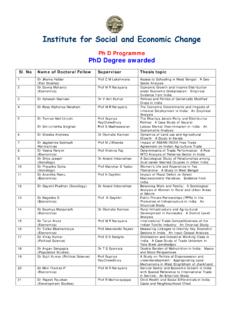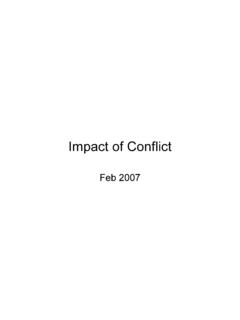Transcription of The Economic Impact of Migration – Productivity
1 1 The Economic Impact of Migration Productivity Analysis for Spain and the UK1 Mari Kangasniemi*, Matilde Mas , Catherine Robinson* and Lorenzo Serrano *National Institute of Economic and social Research, UK2 Ivie and University of Valencia, Spain ABSTRACT Increased internationalization over the past 20 years has meant that labour has become increasingly mobile, and whilst employment and earnings effects have been extensively analysed in host and source nations, the implications for firm and industry performance have been largely ignored. This paper explores the direct Economic consequences of immigration on host nations Productivity performance at a sectoral level.
2 We consider its Impact in two very different European countries, Spain and the UK. Whilst the UK has traditionally had a substantial in-flow of Migration , for Spain, the phenomenon is much more recent. The paper provides an overview of the role played by immigration on per capita income, highlighting the importance of demographic differences. We then go on to analyze the role of Migration on Productivity using two different approaches: i) growth accounting methodology and ii) econometric estimation of a production function. Our findings indicate that Migration has had very different implications for Spain and the UK, migrants being more productive than natives in the UK but less productive than natives in Spain.
3 This may in part be a function of different immigration policies, particularly related to the skill requirements on entry, but also in part a feature of the host nations ability to absorb foreign labour. 1 This research has been funded by the European Commission, Research Directorate General as part of the 6th Framework Programme, Priority 8, Policy Support and Anticipating Scientific and Technological Needs . We are grateful to the EUKLEMS consortium for helpful comments on our initial findings, presented at the EU KLEMS Conference, Brussels, 15-17th March, 2007, the 2008 World Congress on National Accounts and Economic Performance Measures for Nations, Arlington, May 12 17, 2008 and EUKLEMS final congress, Groningen 19th 20th June 2008.
4 M. Mas and L. Serrano acknowledge the support of the Spanish Minister of Education/FEDER grant SEJ2005-02776 2 We would also like to thank Peter Loveridge and Juan Carlos Robledo for their research assistance. 2 1. Introduction In an era of global labour markets Migration can be seen both as a source of invaluable human resources as well as a threat to the relative Economic status of the native workforce. The majority of Economic literature that considers Migration has largely focussed on wage and employment effects on native labour. In many of these studies, micro data has been used to explore the characteristics of migrants and their Impact on native employment and wages in the total economy and often at a regional level (for surveys, see Friedberg & Hunt 1995, Borjas 1999, for US studies see Card 1990, 2001 and 2005, Card & DiNardo 2000, Borjas 2003, and for evidence on Europe, see Angrist and Kugler 2003, Dolado and V zquez, 2007).
5 Similarly, there has been work on migrants instantaneous Impact on wage distribution and the complementarity or substitutability of migrants and natives in the total economy (Grossman 1982, Manacorda et al 2006, Ottaviano and Peri 2006). Bauer and Kunze (2004) have studied the issue using firm level analysis and conclude that most firms workers from EU countries are used to complement domestic high skilled labour, but non-EU migrants are hired because of shortage of appropriate high-skilled labour. In a study of the UK Manacorda et al. (2006) find that migrants and natives are imperfect substitutes.
6 A similar result is obtained by Carrasco, Jimeno and Ortega (2007), for the Spanish case. It remains, however, uncertain whether these aggregated findings carry through to sectoral or firm level or to occupational labour markets. The effects of Migration at the industry level are largely unexplored, as indeed is its Impact on performance indicators, such as Productivity Migration may have an Impact on Economic growth through a number channels, which are largely dependent on the characteristics of the migrants: labour market demographics may change, which will ultimately affect labour participation, activity and employment rates Migrants may be more productive than natives since they represent a selected group of workers, especially in the presence of selective immigration policy low skilled migrant labour may contribute to the expansion of activities related to traditionally low value added and Productivity .
7 Which can ultimately affect industry growth and national Productivity 3 Migrants may have skills that are scarce in the native population and these skills complement native skills in production or influence the adoption of technology (Lewis 2005) Migrants may influence TFP growth through their contribution to innovation (Mattoo et al 2005) or increased knowledge spillovers (Moen 2005) It is clear from these possible channels that the Impact of Migration on host country Productivity will be dependent on the characteristics of those migrating which highlights the importance of immigration policy.
8 With these possible channels in mind, we wish to explore whether relative Productivity differences exists between migrants and natives and if they vary between industries. Also, to what degree is there substitutability or complementarity between migrants and natives? Does it vary between industries? Is there a measurable link between TFP growth and the use of migrant labour? To what extent we can control for differences in labour composition between migrant and native labour? In this work we examine some of these issues for the UK and Spain. We adopt both a growth accounting and an econometric approach using a specially constructed industry panel data.
9 Using both approaches allows us to consider how far the findings are dependent on the various restrictive assumptions, highlighting the strengths and weaknesses of each methodology. The growth accounting approach enables us to look at the Impact by sector more clearly than in the industry panel approach. On the other hand, the econometric approach is less dependent on the assumptions of perfect competition and constant returns to scale and allows exploring the Impact of additional regressors and conducting rigorous statistical tests of the findings.
10 The UK and Spain offer contrasting case studies since they have distinctly different histories as recipient countries of immigration, and therefore offer interesting comparisons. The UK has experienced significant inflow of immigrants since the Second World War. Spain on the other hand has seen mass immigration only relatively recently. It is likely that in these countries migrants differ in their characteristics and sectoral distribution as well as in their contribution to Productivity . 4 The paper is organized as follows: Section 2 briefly outlines the data sources used in this analysis, section 3 presents an overview of recent trends in Migration in Spain and the UK and its Impact on per capita income growth.
